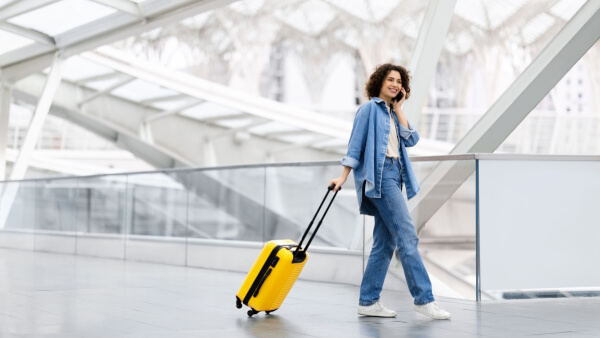Complete Guide to Student Discounts on International Flights from India
Complete guide to student discount on international flights from India. Discover how to get the best deals and save on your study abroad journey.

The Wise Travel card lets you hold 40+ currencies and spend at the interbank exchange rate with no forex markups or hidden fees - now free to order for a limited time.
Order your free Wise Travel card 💳
If you’re coming into India, one of the first orders of business at the airport is Indian customs. Customs helps monitor items being brought into the country.
To make the process smooth and easy, here is a quick guide to the rules and regulations for Indian customs for international travellers.
| 📝 Table of contents |
|---|
All passengers coming into India have to pass a customs check.
The first step is to complete the customs declaration form given out by the airline before disembarking.
Make sure to complete and sign the declaration, and hand it to the immigration officer at the Indian airport.
There are 2 channels for customs clearance- the Red channel and the Green channel. Here is how they differ:
The red channel is for passengers that are carrying prohibited items, or amounts that are above the free allowance, in their baggage.
| ℹ️ Free allowance is the amount of certain items allowed without paying duties | |
| ------------------------------------------------------------------------------ | - |
❌ The list of prohibited or dutiable items are:
- Weapons like firearms
- Over 50 cartridges for firearms
- Carrying more than 100 cigarettes
- Carrying more than 25 cigars
- Tobacco more than 125 grams
- More than 2 litres of alcohol or wines
- Any form of gold or silver, other than jewelry or ornaments
- Flat screen tvs with liquid crystal display, light emitting diode or plasma tvs
- Narcotics or psychotropic substances
- Anything above the free allowance amount
The green channel is for passengers that don’t have items that require a duty payment, or prohibited items, in their baggage.
If you are carrying prohibited items but go through the Green channel, you can be prosecuted and penalized, and your items may be confiscated from you.
✅ Here is a quick list of approved items that you can bring into India:
- Personal items
- Tourist souvenirs
- Liquor, wine or beer up to 2 liters total
- Silver with a weight below 10 kgs
- Up to 2 pets, like dogs and cats, with all the appropriate tests and vaccinations
- In addition to personal items, items up to a value of ₹15,000-50,000 depending on your origin
- Indian residents coming in after more than 1 year abroad can bring ₹1,00,000 worth of jewelry for women, and ₹50,000 worth of jewelry for men
- Approved plants and seeds
- Laptop or a computer within the free allowance amount
There may be other items that are allowed but not covered in this section. Additionally keep up to date with the news to understand changes to the rules.
Here is a quick table for common passengers to India and how much can be brought in:
| Type of passenger | Amount that can be brought in |
|---|---|
| All passengers including NRIs | Foreign currency up to $5,000 US Dollars need to be declared, or traveller cheques and the like up to $10,000 US dollars |
| Indian residents who are returning from travel with Indian rupees | ₹25,000 |
While there is no currency limit for foreign currencies, it does need to be declared if it is above the amount $5,000 in notes/$10,000 in value including traveller cheques.
And if you need to send money to India to reserve hotels, tours, or just for family and friends- Wise lets you send money to local bank accounts in India within minutes for popular routes.
| 💸 Manage 65+ currencies easily with Wise on Web/ Android/ iOS | |
| :-------------------------------------------------------------------------------------------------------------------------------------------------------------------------------------------------------------------------------------: | - |
Open your free Wise account now 🚀
There are two types of customs duty that you can pay when bringing items into India.
The first is individual customs duty for the items you bring, and the second is when you bring in items for trade.
As an individual, if you bring in items that are above and beyond the free allowance, you will have to pay custom duties. This is how it is calculated based on the value of the items:
| Charge | Amount |
|---|---|
| Customs duty charge | 35% |
| Social Welfare charge | 3.5% |
| Total charged | 38.5% |
For a business who is importing into India, it is a little more complicated. The import duty is based on what you are bringing in and what it is made out of. The amount is calculated based on:
There are also additional taxes like Countervailing Due (CVD) and Anti-Dumping Duties that may also be added.
| 💰 Get estimated customs duty costs with our Import Duty calculator | |
| :---------------------------------------------------------------------------------------------------------------: | - |
Here is a quick summary of the duty free allowance for incoming travellers to India:
| Type of passenger | Origin | Maximum Duty Free Allowance |
|---|---|---|
| Indian origin and foreigners above the age of 10 years | Anywhere, except Nepal, Bhutan and Myanmar | ₹50,000 |
| Indian origin and foreigners above the age of 10 years | Nepal, Bhutan and Myanmar | ₹15,000 |
| Foreign tourists | Anywhere | Gifts & souvenirs up to a value of ₹15,000 |
| Indian passengers who have been living abroad for 1+ years | Anywhere | ₹50,000 worth of gold jewelry for men; ₹1,00,000 worth of gold jewelry for women |
| All passengers | Anywhere | Alcohol (liquor, wine and beer) up to 2 litres |
| All passengers | Anywhere | 100 cigarette sticks |
| All passengers | Anywhere | 25 cigars |
| All passengers | Anywhere | 125 grams of tobacco |
| All passengers above the age of 18 years | Anywhere | 1 laptop computer |
All sources checked as of 16 September, 2021
*Please see terms of use and product availability for your region or visit Wise fees and pricing for the most up to date pricing and fee information.
This publication is provided for general information purposes and does not constitute legal, tax or other professional advice from Wise Payments Limited or its subsidiaries and its affiliates, and it is not intended as a substitute for obtaining advice from a financial advisor or any other professional.
We make no representations, warranties or guarantees, whether expressed or implied, that the content in the publication is accurate, complete or up to date.

Complete guide to student discount on international flights from India. Discover how to get the best deals and save on your study abroad journey.

Compare the best travel insurance options for Indian students traveling to studying abroad. Learn about coverage, options, and requirements.

Compare the best health insurance options for Indian students traveling to studying abroad. Learn about coverage, options, and requirements.

Complete Guide to baggage allowance for Indian students traveling abroad. Learn more about extra allowance for international students.

Navigating cash allowances for Indian students traveling to the USA. Know the limits, declarations, and smarter ways to manage your finances abroad.

Understanding TCS on education loan remittances from India. Learn how to minimize TCS and save money with Wise, a convenient option to send money abroad.